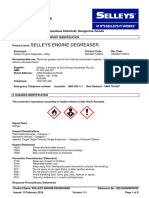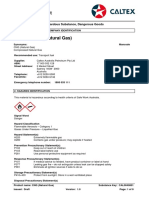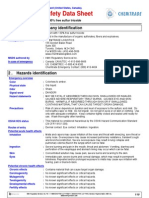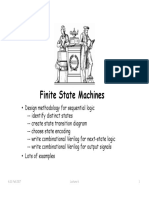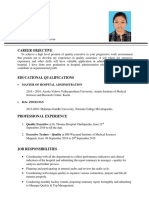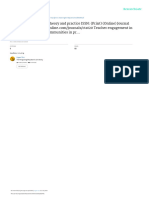Anfo Msds
Anfo Msds
Uploaded by
W N Nan FajarCopyright:
Available Formats
Anfo Msds
Anfo Msds
Uploaded by
W N Nan FajarOriginal Description:
Original Title
Copyright
Available Formats
Share this document
Did you find this document useful?
Is this content inappropriate?
Copyright:
Available Formats
Anfo Msds
Anfo Msds
Uploaded by
W N Nan FajarCopyright:
Available Formats
Material Safety Data Sheet
This material is hazardous according to criteria of NOHSC.
Classified as Dangerous Goods by the criteria of the Australian Code for the Transport of Explosives by Road and Rail.
1. IDENTIFICATION OF THE MATERIAL AND SUPPLIER
Product Name: ANFO
Synonyms: Ammonium nitrate/fuel oil, ANFO 94/6
Supplier: Orica Australia Pty Ltd
ABN: 004 117 828
Street Address: 1 Nicholson Street
Melbourne 3000
Australia
Telephone Number: +61 3 9665 7111
Facsimile: +61 3 9665 7937
Emergency Telephone: 1 800 033 111 (ALL HOURS)
2. COMPOSITION/INFORMATION ON INGREDIENTS
Product Description: Blasting explosive. Granular off-white to pinkish solid with a slight kerosene-like odour.
Various government controls may apply to this material.
Components / CAS Number Proportion Risk Phrases
Ammonium nitrate >60% -
6484-52-2
Fuels, diesel <10% R40 Carc. Cat. 3, R65, R66, R51/53
68334-30-5
Ingredients determined not to <1% -
be hazardous
-
3. HAZARDS IDENTIFICATION
Risk Phrases: Risk of explosion by shock, friction, fire or other sources of ignition. Limited evidence of a
carcinogenic effect.
Poisons Schedule: None allocated.
4. FIRST AID MEASURES
For advice, contact a Poisons Information Centre (Phone eg. Australia 131 126; New Zealand 0 800 764766) or a doctor.
Inhalation: Remove victim from area of exposure - avoid becoming a casualty. Remove contaminated clothing
Product Name: ANFO
Substance No: 000022013201 Issued: 17/08/2005 Version: 3
Page 1 of 7
Material Safety Data Sheet
and loosen remaining clothing. Allow patient to assume most comfortable position and keep warm.
Keep at rest until fully recovered. If patient finds breathing difficult and develops a bluish
discolouration of the skin (which suggests a lack of oxygen in the blood - cyanosis), ensure airways
are clear of any obstruction and have a qualified person give oxygen through a face mask. Apply
artificial respiration if patient is not breathing. Seek immediate medical advice.
Skin Contact: If skin contact occurs, remove contaminated clothing and wash skin with running water. If irritation
occurs seek medical advice. Nitrates can be absorbed through cut, burnt or broken skin. Launder
clothing before reuse.
Eye Contact: If in eyes, wash out immediately with water. In all cases of eye contamination it is a sensible
precaution to seek medical advice.
Ingestion: Rinse mouth with water. If swallowed, do NOT induce vomiting. Give a glass of water. Seek
medical advice.
Notes to physician: Explosive material. Treat symptomatically and as for exposure to hydrocarbon solvents. Treat as
for exposure to nitrates. For ammonium nitrate: May cause methemoglobinemia. Clinical findings:
The smooth muscle relaxant effect of nitrate salts may lead to headache, dizziness and marked
hypotension.
Cyanosis is clinically detectable when approximately 15% of the haemoglobin has been converted
to methaemoglobin (ie. ferric iron).
Symptoms such as headache, dizziness, weakness and dyspnoea occur when methaemoglobin
concentrations are 30% to 40%; at levels of about 60%, stupor, convulsions, coma and respiratory
paralysis occur and the blood is a chocolate brown colour. At higher levels death may result.
Spectrophotometric analysis can determine the presense and concentration of methaemoglobin in
blood.
Treatment:
1. Give 100% oxygen.
2. In cases of (a) ingestion: use gastric lavage, (b) contamination of skin (unburnt or burnt):
continue washing to remove salts.
3. Observe blood pressure and treat hypotension if necessary.
4. When methaemoglobin concentrations exceed 40% or when symptoms are present, give
methylene blue 1 to 2 mg/kg body weight in a 1% solution by slow intravenous injection. If
cyanosis has not resolved within one hour a second dose of 2 mg/kg body weight may be given.
The total dose should not exceed 7 mg/kg body weight as unwanted effects such as dyspnoea,
chest pain, vomiting, diarrhoea, mental confusion and cyanosis may occur. Without treatment
methaemoglobin levels of 20-30% revert to normal within 3 days.
5. Bed rest is required for methaemoglobin levels in excess of 40%.
6. Continue to monitor and give oxygen for at least two hours after treatment with methylene blue.
7. Consider transfer to centre where haemoperfusion can be performed to remove the nitrates from
the blood if the condition of the patient is unstable.
8. Following inhalation of oxides of nitrogen the patient should be observed in hospital for 24 hours
for delayed onset of pulmonary oedema.
Further observation for 2-3 weeks may be required to detect the onset of the inflammatory changes
of bronchiolitis fibrosa obliterans.
5. FIRE FIGHTING MEASURES
Specific Hazards: Explosive material. Avoid all ignition sources.
Fire-fighting advice: In case of a small fire, if actual explosive is not burning, carefully remove as much
explosive as possible to a safe distance. Fire fighters to wear self-contained breathing
apparatus if risk of exposure to vapour or products of combustion. However, if
explosive is burning, evacuate area immediately. Do NOT fight fire. On burning under
Product Name: ANFO
Substance No: 000022013201 Issued: 17/08/2005 Version: 3
Page 2 of 7
Material Safety Data Sheet
confined or semi-confined conditions, some oxides of nitrogen and/or carbon
monoxide will be present. Brown fumes indicate the presence of toxic oxides of
nitrogen.
A major fire may involve a risk of explosion. An adjacent detonation may also involve
the risk of explosion.
6. ACCIDENTAL RELEASE MEASURES
Clear area of all unprotected personnel. Shut off all possible sources of ignition. Wear protective equipment to prevent
skin and eye contact. Contain - prevent run off into drains and waterways. Collect in properly labelled containers, with
loose fitting lids, for disposal. Use a spark-free shovel. If contamination of sewers or waterways has occurred advise local
emergency services. In the case of a transport accident notify the Police, Explosives Inspector and Orica Australia Pty Ltd
(Telephone: 1800 033 111 -- 24 hour service) and/or Orica New Zealand Pty Ltd (Telephone: 0800 734 607 -- 24 hour
service).
Spillage recovery needs to be appropriately documented and material accurately accounted for. This material contains
SSAN (Security Sensitive Ammonium Nitrate).
7. HANDLING AND STORAGE
Handling advice: Avoid skin and eye contact and breathing in vapour. Do NOT subject the material to impact, friction
between hard surfaces nor to any form of heating. Avoid all contact with other chemicals.
Storage advice: Store material in a well ventilated magazine suitably licensed for Class 1.1D Explosives. Store in a
cool, dry, well ventilated place and out of direct sunlight. Store away from sources of heat or ignition.
Store away from incompatible materials described in Section 10. Store away from strong acids,
strong alkalis, nitrites, chlorates, chlorides and permanganates. Ammonium Nitrate is incompatible
with, and must be stored away from, tetranitromethane, dichloroisocyanuric acid, trichloroisocyanuric
acid, any bromate, chlorate, chlorite, hypochlorite or chloroisocyanurate or any inorganic nitrite. Keep
containers closed when not in use - check regularly for spills.
Ensure this material (which contains ammonium nitrate (SSAN)) is stored securely and in
accordance with regulations/controls issued by the relevant authority. Secure storage may involve
locking the facility/container or constant surveillance.
8. EXPOSURE CONTROLS/PERSONAL PROTECTION
Occupational Exposure Limits:
No value assigned for this specific material by the National Occupational Health and Safety Commission.
Supplier recommended Exposure Standard: Diesel Oil: 500 mg/m3 total vapour (approx 100 ppm) or 5 mg/m3 stable
aerosols for 8 hour time-weighted average (TWA). (1)
TWA - The time-weighted average airborne concentration over an eight-hour working day, for a five-day working week
over an entire working life.
These Exposure Standards are guides to be used in the control of occupational health hazards. All atmospheric
contamination should be kept to as low a level as is workable. These exposure standards should not be used as fine
Product Name: ANFO
Substance No: 000022013201 Issued: 17/08/2005 Version: 3
Page 3 of 7
Material Safety Data Sheet
dividing lines between safe and dangerous concentrations of chemicals. They are not a measure of relative toxicity.
Engineering Control Measures:
Ensure ventilation is adequate and that air concentrations of components are controlled below quoted Exposure
Standards. Use in well ventilated areas.
Personal Protective Equipment:
Orica Personal Protection Guide No. 1, 1998: B - OVERALLS, SAFETY SHOES, SAFETY GLASSES, GLOVES.
Wear overalls, safety glasses and impervious gloves. Always wash hands before smoking, eating, drinking or using the
toilet. Wash contaminated clothing and other protective equipment before storage or re-use.
9. PHYSICAL AND CHEMICAL PROPERTIES
Physical state: Granular Solid
Colour: Off-white or Pink
Odour: Slight , Kerosene
Solubility: Partially soluble in water.
Specific Gravity: 0.8 @ 20°C
Flash Point (°C): > 61
10. STABILITY AND REACTIVITY
Stability: Incompatible with combustible material , oxidising agents , permanganates , strong acids and alkalis . Avoid
contact with other chemicals. Detonation may occur from heavy impact or excessive heating, particularly
under confinement. Ammonium nitrate is a powerful oxidising agent. It is incompatible with
tetranitromethane, dichloroisocyanuric acid, trichloroisocyanuric acid, any bromate, chlorate, chlorite,
hypochlorite or chloroisocyanurate, any inorganic nitrite and metal powders. When heated to decomposition
(unconfined) it produces nitrous oxide, white ammonium nitrate fumes and water. When mixed with strong
acids, and occasionally during blasting, it produces an irritating toxic brown gas, mostly of nitrogen dioxide.
When molten may decompose violently due to shock or pressure.
11. TOXICOLOGICAL INFORMATION
No adverse health effects expected if the product is handled in accordance with this Safety Data Sheet and the product
label. Symptoms or effects that may arise if the product is mishandled and overexposure occurs are:
Ingestion: Swallowing can result in nausea, vomiting, diarrhoea, and abdominal pain. Swallowing large amounts
may result in headaches, dizziness and a reduction in blood pressure (hypotension).
Eye contact: May be an eye irritant.
Skin contact: Contact with skin may result in irritation. Will have a degreasing action on the skin. Repeated or
prolonged skin contact may lead to irritant contact dermatitis. Can be absorbed through cut, broken, or
burnt skin with resultant adverse effects. See effects as noted under 'Inhalation'.
Inhalation: Material may be irritant to the mucous membranes of the respiratory tract (airways). Breathing in vapour
can result in headaches, dizziness, drowsiness, and possible nausea. Blasting may produce a toxic brown
gas of nitrogen dioxide. Inhalation of the gas may result in chest discomfort, shortness of breath and
Product Name: ANFO
Substance No: 000022013201 Issued: 17/08/2005 Version: 3
Page 4 of 7
Material Safety Data Sheet
possible pulmonary oedema, the onset of which may be delayed.
Absorption of ammonium nitrate by inhalation, ingestion or through burnt or broken skin may cause
dilation of blood vessels by direct smooth muscle relaxation and may also cause methaemoglobinaemia.
(2)
Long Term Effects:
No information available for the product. Available evidence from animal studies indicate that repeated or prolonged
exposure to a component of this material could result in effects on the skin. This material contains within the diesel oil
component of this formulation polycyclic aromatic hydrocarbons (PAHs). Some PAHs have been implicated as potential
skin carcinogens in humans under conditions of poor personal hygiene, prolonged or repeated skin contact and exposure
to sunlight. Toxic effects are unlikely to occur if good personal hygiene is practised. (1)
Toxicological Data:
No LD50 data available for the product. For the constituent AMMONIUM NITRATE: (2):
Oral LD50 (rat): 2217 mg/kg.
In humans and animals methaemoglobinaemia has occurred under untreated circumstances following the ingestion of
nitrates. (2)
12. ECOTOXICOLOGICAL INFORMATION
Avoid contaminating waterways.
Aquatic toxicity:
Toxic to aquatic organisms. May cause long term adverse effects in the aquatic environment. Ammonium nitrate was
evaluated at 5, 10, 25 and 50 mg (NH4+)/L.
The fertility of Daphnia magna was decreased at 50 mg/L. Post embryonic growth of crustacea was impaired at 10, 25
and 50 mg/L. (2)
13. DISPOSAL CONSIDERATIONS
Refer to Waste Management Authority. Dispose of material through a licensed waste contractor. Small quantities of
damaged or deteriorated explosives may be destroyed by inclusion in a blast hole containing good explosive(s). For large
quantities of damaged or deteriorated explosives notify Orica Australia Pty Ltd and/or Orica New Zealand Pty Ltd.
Disposal of this material (which contains ammonium nitrate (SSAN)) needs to be appropriately documented and all
material accurately accounted for.
14. TRANSPORT INFORMATION
Road and Rail Transport
Classified as Dangerous Goods by the criteria of the Australian Code for the Transport of Explosives by Road and Rail.
Product Name: ANFO
Substance No: 000022013201 Issued: 17/08/2005 Version: 3
Page 5 of 7
Material Safety Data Sheet
UN No: 0082
Class-primary 1.1 D Explosive
Proper Shipping Name: EXPLOSIVE, BLASTING, TYPE B
Hazchem Code: E
Marine Transport
Classified as Dangerous Goods by the criteria of the International Maritime Dangerous Goods Code (IMDG Code) for
transport by sea.
UN No: 0082
Class-primary: 1.1 D Explosive
Proper Shipping Name: EXPLOSIVE, BLASTING, TYPE B
Air Transport
TRANSPORT PROHIBITED under the International Air Transport Association (IATA) Dangerous Goods Regulations for
transport by air in passenger aircraft and cargo aircraft.
15. REGULATORY INFORMATION
Classification: This material is hazardous according to criteria of NOHSC.
Xn: Harmful
Risk Phrase(s): R2: Risk of explosion by shock, friction, fire or other sources of ignition.
R40: Limited evidence of a carcinogenic effect.
Safety Phrase(s): S16: Keep away from sources of ignition - No smoking.
S24: Avoid contact with skin.
S36/37: Wear suitable protective clothing and gloves.
Poisons Schedule: None allocated.
All the constituents of this material are listed on the Australian Inventory of Chemical Substances (AICS).
Various regulations/controls/authorisations/licences may apply governing the manufacture, importation, exportation, use,
handling, storage, sale/supply, transport and disposal of ammonium nitrate and ammonium nitrate containing materials.
Ammonium nitrate (SSAN - Security Sensitive Ammonium Nitrate) and materials containing ammonium nitrate may be
considered security sensitive materials and loss, theft, attempted theft or unexplained discrepencies may need to be
reported to authorities. Record keeping and/or licensing of individuals may be required.
16. OTHER INFORMATION
(1) Supplier Material Safety Data Sheet; 12/2002
(2) Material Safety Data Sheet - Orica Australia Pty Ltd; 08/ 2004.
Product Name: ANFO
Substance No: 000022013201 Issued: 17/08/2005 Version: 3
Page 6 of 7
Material Safety Data Sheet
PACIA Code of Practice for Secure Distribution of High Analysis Ammonium Nitrate. 03/ 2004.
Probe Analytical report (Flash Point Determination), Request No. 950761, June, 1995.
This material safety data sheet has been prepared by SH&E Shared Services, Orica.
Reason(s) for Issue:
5 Yearly Revised Primary MSDS
This MSDS summarises to our best knowledge at the date of issue, the chemical health and safety hazards of the
material and general guidance on how to safely handle the material in the workplace. Since Orica Limited cannot
anticipate or control the conditions under which the product may be used, each user must, prior to usage, assess and
control the risks arising from its use of the material.
If clarification or further information is needed, the user should contact their Orica representative or Orica Limited at the
contact details on page 1.
Orica Limited's responsibility for the material as sold is subject to the terms and conditions of sale, a copy of which is
available upon request.
Product Name: ANFO
Substance No: 000022013201 Issued: 17/08/2005 Version: 3
Page 7 of 7
You might also like
- AlgoRyze Pro-SolDocument23 pagesAlgoRyze Pro-Solmoleno56No ratings yet
- Manual Trans Overhaul Chevrolet S10Document11 pagesManual Trans Overhaul Chevrolet S10Maxi Sardi100% (1)
- Effects On PPC Due To Various Govt. PoliciesDocument20 pagesEffects On PPC Due To Various Govt. PoliciesNaman Verma54% (391)
- SANS1200DADocument15 pagesSANS1200DAFlavioMuhale100% (1)
- Executive SummaryDocument63 pagesExecutive SummaryNilesh MeenaNo ratings yet
- Senatel Magnum MSDSDocument7 pagesSenatel Magnum MSDSSimon SamNo ratings yet
- MSDS UG Bulk Emulsion PhaseDocument7 pagesMSDS UG Bulk Emulsion PhaseEli SilvaNo ratings yet
- Safety Data Sheet: 1. Identification of The Material and Supplier Ammonium NitrateDocument10 pagesSafety Data Sheet: 1. Identification of The Material and Supplier Ammonium NitrateGilberto Josué MartínezNo ratings yet
- Na NO3Document8 pagesNa NO3SabariyantoNo ratings yet
- Sodium Nitrate SDSDocument8 pagesSodium Nitrate SDSemeka2012No ratings yet
- Alcohol Hand Sanitiser-SdsDocument8 pagesAlcohol Hand Sanitiser-SdsArdiah NopriNo ratings yet
- SDS - Surface Sensitised Bulk Emulsion - Rev 03Document13 pagesSDS - Surface Sensitised Bulk Emulsion - Rev 03LeandroNo ratings yet
- Hoja de Seguridad - Amex LD (Inglés)Document5 pagesHoja de Seguridad - Amex LD (Inglés)Pedro Ramos PAchecoNo ratings yet
- Aluminium Cleaner Brightener-Aust - SDSDocument8 pagesAluminium Cleaner Brightener-Aust - SDSyp98519No ratings yet
- Acetone: Safety Data SheetDocument8 pagesAcetone: Safety Data SheetPunit PurshotamNo ratings yet
- Mek - MSDSDocument8 pagesMek - MSDSAbdelrahman AwadallahNo ratings yet
- Septone Brake Dust Cleaner SDSDocument15 pagesSeptone Brake Dust Cleaner SDSMarkSomniumNo ratings yet
- Larvin375 MSDS 0907Document7 pagesLarvin375 MSDS 0907Nugroho HartonoNo ratings yet
- MSDS - Nital Etchant (Syncrude)Document5 pagesMSDS - Nital Etchant (Syncrude)Claudia MmsNo ratings yet
- Safety Data Sheet: 1. Identification of The Material and Supplier Methoxy PropanolDocument8 pagesSafety Data Sheet: 1. Identification of The Material and Supplier Methoxy PropanolPamela E. PeñaNo ratings yet
- SENATEL POWERFRAG - Shess-En-Mtr-Ughs-000000009253 PDFDocument11 pagesSENATEL POWERFRAG - Shess-En-Mtr-Ughs-000000009253 PDFAkaru KoupaNo ratings yet
- Aqueous AmoniaDocument7 pagesAqueous AmoniaArief Rahman DhuhriNo ratings yet
- Methanol MSDSDocument8 pagesMethanol MSDSZubaidi OthmanNo ratings yet
- Selleys Engine Degreaser-Aus GHSDocument9 pagesSelleys Engine Degreaser-Aus GHSFloyd PriceNo ratings yet
- Safety Data Sheet: 1. Identification of The Material and Supplier YID000038Document8 pagesSafety Data Sheet: 1. Identification of The Material and Supplier YID000038FahrezaNo ratings yet
- Iso Propyl AlcoholDocument9 pagesIso Propyl AlcoholLinda NemethNo ratings yet
- Caustic Soda 99 - Aus SdsDocument8 pagesCaustic Soda 99 - Aus SdsThatoNo ratings yet
- MSDS Potassium DichromateDocument6 pagesMSDS Potassium DichromateIgede Sadiamba PNo ratings yet
- Sodium Nitrite SDSDocument7 pagesSodium Nitrite SDSemeka2012No ratings yet
- Safety Data SheetDocument7 pagesSafety Data SheetOperations AdminNo ratings yet
- 07 Megapoxy 267-PartADocument9 pages07 Megapoxy 267-PartAroy.victorNo ratings yet
- ADESILEX T IT - 362 - en - 900601 - 201407020118260O6IDocument10 pagesADESILEX T IT - 362 - en - 900601 - 201407020118260O6IAntonio Romero ArangoNo ratings yet
- Ecocool 700 NBF M - SdsDocument7 pagesEcocool 700 NBF M - Sdsgalih rahmanNo ratings yet
- 015 Mineral TurpentineDocument8 pages015 Mineral TurpentineLucaNo ratings yet
- Safety Data Sheet: 1. Identification of The Material and Supplier Ixosurf LabsDocument7 pagesSafety Data Sheet: 1. Identification of The Material and Supplier Ixosurf LabsJoseNo ratings yet
- MSDS Sodium NitriteDocument5 pagesMSDS Sodium NitritemarcNo ratings yet
- Ceplattyn 300 Spray-SdsDocument7 pagesCeplattyn 300 Spray-SdsDương LêNo ratings yet
- 4-Amino-3-Hydroxynapthlene-1-Sulphonic AcidDocument8 pages4-Amino-3-Hydroxynapthlene-1-Sulphonic AcidIqraNo ratings yet
- Chemwatch Australian MSDS 6632-96Document15 pagesChemwatch Australian MSDS 6632-96Vijo JoseNo ratings yet
- MSDS 450 HDocument9 pagesMSDS 450 HMohammad AseefNo ratings yet
- NALCO® EC9149A: Section 1. Identification of The Substance/Mixture and of The Company/UndertakingDocument14 pagesNALCO® EC9149A: Section 1. Identification of The Substance/Mixture and of The Company/UndertakingDonatas BertasiusNo ratings yet
- Safety Data Sheet: 1. Identification of The Material and Supplier RP7Document6 pagesSafety Data Sheet: 1. Identification of The Material and Supplier RP7aminNo ratings yet
- Eng Msds SHL Edm 32 (Re11)Document6 pagesEng Msds SHL Edm 32 (Re11)duyvuNo ratings yet
- Resina MEGAPOXY HICB-Part-A-Version-2.0 - Ficha Segurança - ENGDocument9 pagesResina MEGAPOXY HICB-Part-A-Version-2.0 - Ficha Segurança - ENGfernando.luis.mariaNo ratings yet
- Safety Data Sheet: 1. Identification of The Material and Supplier Oil of OrangeDocument6 pagesSafety Data Sheet: 1. Identification of The Material and Supplier Oil of OrangenephylymNo ratings yet
- Hydrochloric Acid 33%: Safety Data SheetDocument8 pagesHydrochloric Acid 33%: Safety Data SheetsenguttuvanNo ratings yet
- Ethanol Solution: Safety Data SheetDocument8 pagesEthanol Solution: Safety Data SheetIzhharuddinNo ratings yet
- Mono Ethylene Glycol MEGDocument6 pagesMono Ethylene Glycol MEGtabriz.alizada.engNo ratings yet
- Material Safety Data Sheet: ProductDocument12 pagesMaterial Safety Data Sheet: ProductOmar EzzatNo ratings yet
- Safety Data Sheet: Hazardous Substance, Dangerous GoodsDocument8 pagesSafety Data Sheet: Hazardous Substance, Dangerous GoodsRocky RamNo ratings yet
- 30H-Line Premium S/B Metal Protect Flat Base: Safety Data SheetDocument8 pages30H-Line Premium S/B Metal Protect Flat Base: Safety Data SheetFariza SiswantiNo ratings yet
- Msds PlutoniumDocument12 pagesMsds PlutoniumarizNo ratings yet
- Methoxypropylamine MOPA C4H11NO 5332 73 0 SDSDocument8 pagesMethoxypropylamine MOPA C4H11NO 5332 73 0 SDStaraNo ratings yet
- Oleum EnglishDocument10 pagesOleum Englishhyde2520015754No ratings yet
- Safety Data Sheet: 1. Identification of The Material and Supplier Aluminium Sulfate SolidDocument6 pagesSafety Data Sheet: 1. Identification of The Material and Supplier Aluminium Sulfate SolidrezaNo ratings yet
- Material Safety Data Sheet: Section 1 - Chemical Product and Company IdentificationDocument6 pagesMaterial Safety Data Sheet: Section 1 - Chemical Product and Company IdentificationHazama HexNo ratings yet
- Material Safety Data Sheet: Section 1 - Chemical Product and Company IdentificationDocument6 pagesMaterial Safety Data Sheet: Section 1 - Chemical Product and Company IdentificationHazama HexNo ratings yet
- Protecta: Safety Data SheetDocument7 pagesProtecta: Safety Data SheetAnanthanarayananNo ratings yet
- Emulson Paint MSDSDocument9 pagesEmulson Paint MSDSMaiyalagar LeelaigalNo ratings yet
- RP7-NZ SDSDocument8 pagesRP7-NZ SDSRùa ConNo ratings yet
- Engine Flush: Safety Data SheetDocument7 pagesEngine Flush: Safety Data SheetFebrianto DimazNo ratings yet
- Moly Plus-SDSDocument7 pagesMoly Plus-SDSaldyyp736No ratings yet
- All Purpose Thinner Sep11Document4 pagesAll Purpose Thinner Sep11Paul De ChaufepieNo ratings yet
- Session 4b 410Document27 pagesSession 4b 410W N Nan FajarNo ratings yet
- Session 11b 230pmDocument19 pagesSession 11b 230pmW N Nan FajarNo ratings yet
- The Effect of Delay Time On Fragmentation Distribution Through Small and Medium Scale Testing and AnalysisDocument25 pagesThe Effect of Delay Time On Fragmentation Distribution Through Small and Medium Scale Testing and AnalysisW N Nan FajarNo ratings yet
- Fireline RDX Cord TDSDocument2 pagesFireline RDX Cord TDSW N Nan FajarNo ratings yet
- Ballistic Disc 260 - 1Document2 pagesBallistic Disc 260 - 1W N Nan FajarNo ratings yet
- Session 11a 150Document27 pagesSession 11a 150W N Nan FajarNo ratings yet
- ANFO TdsDocument2 pagesANFO TdsW N Nan FajarNo ratings yet
- Integrated Technology Solution For Optimised and Environmentally Controlled BlastsDocument29 pagesIntegrated Technology Solution For Optimised and Environmentally Controlled BlastsW N Nan FajarNo ratings yet
- Infladeck PresentationDocument14 pagesInfladeck PresentationW N Nan FajarNo ratings yet
- Risk Assessment and Prediction of Rock Fragmentation Produced by Blasting Operation A Rock Engineering SystemDocument13 pagesRisk Assessment and Prediction of Rock Fragmentation Produced by Blasting Operation A Rock Engineering SystemW N Nan FajarNo ratings yet
- Inhole Density MeasurementDocument9 pagesInhole Density MeasurementW N Nan Fajar100% (1)
- Seismic Velocites and Materials: Relating Geology To VelocityDocument3 pagesSeismic Velocites and Materials: Relating Geology To VelocityW N Nan FajarNo ratings yet
- Accounting For CorporationDocument19 pagesAccounting For CorporationAbdi Mucee TubeNo ratings yet
- The Six Main Function of HR Are RecruitmentDocument2 pagesThe Six Main Function of HR Are RecruitmentAman DeepNo ratings yet
- Paket Wisata Kelompok 2Document28 pagesPaket Wisata Kelompok 2Desak DepinNo ratings yet
- It SabDocument13 pagesIt SabDK's GamingNo ratings yet
- Jeep Liberty Limited 2006 - 2006 ELECTRICAL Fuses Circuit Breakers LibertyDocument10 pagesJeep Liberty Limited 2006 - 2006 ELECTRICAL Fuses Circuit Breakers LibertyAron LabastidaNo ratings yet
- L06Document32 pagesL06Aliya SarunNo ratings yet
- SalmaDocument10 pagesSalmaSalma ChaeraniNo ratings yet
- Phoshorus Xsys0015 CDocument4 pagesPhoshorus Xsys0015 CAniket DubeyNo ratings yet
- Com - Iocl LPGSV 150001046354011Document2 pagesCom - Iocl LPGSV 150001046354011sunil78No ratings yet
- Marketing Assessment 1 - Group 9Document7 pagesMarketing Assessment 1 - Group 9thienminhNo ratings yet
- Del-Chand Bus TicketDocument2 pagesDel-Chand Bus TicketAnkur GuptaNo ratings yet
- Ashna's Resume-CompressedDocument2 pagesAshna's Resume-CompressedAkhil GirijanNo ratings yet
- CV DeveloperDocument3 pagesCV DeveloperJohari MunawwarahNo ratings yet
- Ansamarykl (1 2) PDFDocument3 pagesAnsamarykl (1 2) PDFsherrymattNo ratings yet
- Junior Auditor SyllabusDocument4 pagesJunior Auditor SyllabusMenu GargNo ratings yet
- SAC 11 KV Line (5280')Document9 pagesSAC 11 KV Line (5280')John Nash Tun100% (1)
- The Balance of Payments and The Exchange RateDocument10 pagesThe Balance of Payments and The Exchange RateOtis MelbournNo ratings yet
- Teacher engagement in professional learning communities in preschool contextsDocument23 pagesTeacher engagement in professional learning communities in preschool contextsdaisy1041697640No ratings yet
- MCWC QBDocument9 pagesMCWC QBvishal sahooNo ratings yet
- PDF 545 1 Roadmap b1 Studentsx27 Book 2019 160p CompressDocument161 pagesPDF 545 1 Roadmap b1 Studentsx27 Book 2019 160p CompressPaulina PietryjaNo ratings yet
- HSE Violation NoticeDocument1 pageHSE Violation NoticeDLPS HSENo ratings yet
- Design and Evaluation Philosophy: ASCE 2016 FEMA 2015Document13 pagesDesign and Evaluation Philosophy: ASCE 2016 FEMA 2015Pastor PachecoNo ratings yet
- Regulating Act, 1773, Constitutional HistoryDocument3 pagesRegulating Act, 1773, Constitutional HistoryKaran SinghNo ratings yet
- Basic CNC Programming V2Document76 pagesBasic CNC Programming V2nuzul hamdani100% (1)
- APC ConfigureDocument6 pagesAPC ConfigureTrọng Lý TrầnNo ratings yet























